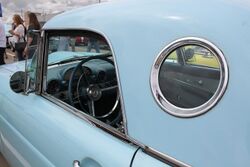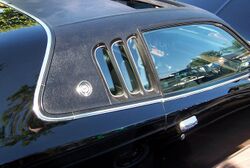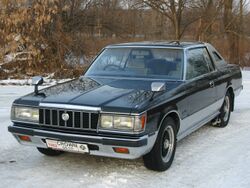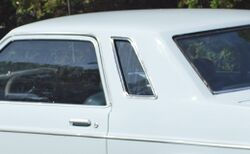Engineering:Opera window
An opera window is a small fixed window usually behind the rear side window of an automobile.[1] They are typically mounted in the C-pillar of some cars.[2] The design feature was popular during the 1970s and early 1980s and adopted by domestic U.S. manufacturers, most often with a vinyl roof.[2]
The origin was from "opera" vehicles of around 1915 with occasional collapsible seating for extra passengers.[3] The opera window was also a feature on "formal roof" and limousine models with higher than a normal roof to accommodate passengers with top hats.[3]
History
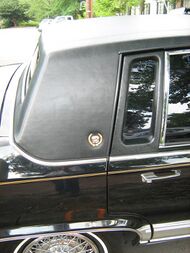
The design element of a distinct, fixed, centered opera window was borrowed from such windows in horse-drawn carriages and used during the classical era of automobile styling. For example, "the Elcar in 1924 was good looking ... and even a fabric top in the style of a brougham with oval opera windows framed by landau bars".[4] Opera windows saw their demise in the 1930s.
Perhaps the most notable return was the "porthole" in the 1956–1957 Ford Thunderbird. It was provided as an option to improve rear-quarter visibility with the removable hardtop in place. "The hottest thing going was the 'porthole' window in the rear side pillar – called 'opera windows' – that came in during the horse and buggy [era]".[5]
Opera windows began reappearing in the early 1970s in such vehicles as the 1972 Continental Mark IV. Almost all personal luxury cars would adopt opera windows, usually framed by a vinyl roof.[6] Most often, opera window variants were applied on two-door hardtop or coupé models, spanning all types of vehicles from economy compacts to flagship personal luxury cars, in which latter exploding realm they became "recognition elements" seeking to add a vintage element to their styling.[7] General Motors introduced an all-new line of mid-sized "Colonade" models for the 1973 model year. Standard on all the coupes was a fixed triangular rear quarter window while higher trim versions used a rectangular vertical opera window.[8]
In some cars, an additional feature was the so-called opera light that was mounted on the outside of the B-pillar or C-pillar and illuminated when the exterior lights were switched on.
Function
The windows were intended to offset the significant blind spots created by wide C-pillars that were characteristic of many American cars produced at this time.[9] In an age of decreasing dimensions and increasingly common use of non-opening rear side windows on 2-door models, a variety of shapes of rear windows may have helped passengers there to feel somewhat less claustrophobic.[citation needed]
These windows were usually non-functional; however, in the case of the AMC Matador coupe NASCAR racers, the standard roll-down quarter windows were causing aerodynamic drag.[10][11] Penske racing requested AMC a small "porthole" to smooth the airflow when open to the wind under racing conditions.[12] To qualify as a stock item for use on the tracks, NASCAR required 500 units must be available to the public.[11] The small opera window was first an optional "D/L Formal Window Package" on the Brougham models and then a standard feature on the Barcelona II trim package.[11][13][14]
Examples
- AMC Concord (1978–1982 coupe, 1980–1983 4-door sedan)[15][16]
- AMC Eagle coupe (1980–1988), 4-door (1980–1988)[17]
- AMC Matador coupe: D/L Formal Window Package (1974–1975) and Barcelona (1976–1978)[18][19][20][21]
- Buick Regal coupe (1973–1977)
- Buick Riviera (1974–1978)[22]
- Cadillac Coupe de Ville (1974–1979, 1985–1993)
- Cadillac Sedan de Ville (1975–1976)
- Cadillac Eldorado (1971–1978)
- Cadillac Fleetwood Brougham coupe (1980–1985)
- Cadillac Fleetwood coupe (1985–1986, 1989–1992)
- Cadillac Sixty Special coupe (1993)
- Cadillac Fleetwood 75 series (1971–1976, 1985–1987)
- Cadillac Fleetwood limousine (1977–1984)
- Chevrolet Caprice (1974–1980)[23]
- Chevrolet Chevelle coupe (including Malibu and Laguna, 1973–1977)[24]
- Chevrolet Concours coupe (1976–1977)[25][26]
- Chevrolet Impala (1974–1976)
- Chevrolet Monte Carlo (1973–1977, 1981–1988)[27]
- Chrysler Cordoba (1975–1983)[28]
- Chrysler LeBaron coupe (1977–1986)
- Chrysler Newport (1976–1978)[29]
- Chrysler New Yorker (1974–1978)
- Chrysler TC by Maserati (1989–1991) on the removable hardtop[30]
- Citroën BX Series 1 (1982–1986)
- Continental Mark IV, V & VI (1972–1983)[31]
- Daihatsu Charade Runabout (G10/20, 1978–1983)[32][33]
- Dodge 400 (1981–1983)
- Dodge 600 coupe (1984–1986)
- Dodge Aries 2-door (1981–1989)
- Dodge Aspen coupe (1976–1980)[34]
- Dodge Charger (1973–1978)
- Dodge Diplomat coupe (1977–1981)
- Dodge Magnum (1978–1979)[35]
- Dodge Mirada (1980–1983)
- Dodge Monaco coupe (1977–1978)
- Dodge Royal Monaco coupe (1974–1977)
- Ford Elite (1974–1976)
- Ford Granada 2-door (1975–1980)
- Ford Mustang II Ghia (1975–1978)[36]
- Ford LTD, Crown Victoria 2-door (1975–1987)
- Ford LTD II (1977–1979)
- Ford Thunderbird (1956–1957, 1973–1982, 2002–2005)
- Ford Torino 2-door (1974–1976)[37]
- Imperial LeBaron coupe (1974–1975)
- Lincoln Continental (1975–1980)
- Lincoln Town Car (1981–1997)
- Mazda RX-5 (1975–1980)
- Mercury Cougar (1974–1982)
- Mercury Marquis, Grand Marquis 2-door (1979–1987)
- Mercury Monarch 2-door (1975–1980)[38]
- Mercury Montego 2-door (1974–1976)
- Nissan Silvia S110 series 2-door coupe (1979–1983)
- Oldsmobile 88 (1974–1984)
- Oldsmobile 98 (1974–1987)
- Oldsmobile Cutlass coupe (1973–1977)
- Oldsmobile Cutlass Calais coupe (1981–1984)
- Oldsmobile Cutlass Salon coupe (1985–1988)
- Oldsmobile Cutlass Supreme (1973–1988)
- Oldsmobile Omega coupe (1975–1979)
- Oldsmobile Toronado (1974–1978)
- Pontiac Bonneville (1975–1979)
- Pontiac Catalina (1974–1976)
- Pontiac Grand Am coupe (1973–1977)
- Pontiac Grand Prix (1973–1987)
- Pontiac Grand Ville (1974–1975)
- Pontiac Lemans coupe (1973–1980)[39]
- Pontiac Phoenix coupe (1977–1979)
- Pontiac Sunbird notchback coupe (1976–1980)
- Pontiac Ventura coupe (1975–1979)
- Plymouth Gran Fury (1974–1977)
- Plymouth Fury (1976–1978)
- Plymouth Reliant 2-door (1981–1989)
- Plymouth Volare coupe (1976–1980)[34]
- Toyota Carina Van TA16V/19V (1975–1977)[40]
- Toyota Crown coupe (1979–1983)[41]
See also
References
- ↑ "Oxford Dictionary: definition of Opera Window". Lexico Dictionaries. https://www.lexico.com/en/definition/opera_window.[|permanent dead link|dead link}}]
- ↑ 2.0 2.1 "1975 Cadillac Fleetwood Eldorado". http://www.conceptcarz.com/vehicle/z11551/default.aspx.
- ↑ 3.0 3.1 Haajanen, Lennart W. (2017). Illustrated Dictionary of Automobile Body Styles (Second ed.). McFarland. pp. 80, 112. ISBN 978-0-7864-9918-2. https://books.google.com/books?id=6GQoDwAAQBAJ&dq=Coupe+cars+Quarter+Opera+windows&pg=PA112. Retrieved 26 November 2022.
- ↑ Locke, William S. (2000). Elcar and Pratt automobiles: the complete history. McFarland. p. 71. ISBN 978-0-7864-0956-3.
- ↑ Szudarek, Robert (2000). The first century of the Detroit Auto Show. Warrendale, Pennsylvania: Society of Automotive Engineers. p. 210. ISBN 978-0-7680-0502-8.
- ↑ Stern, Milton (April 2018). "The Peak of Personal Luxury". Hemmings Classic Car. https://www.hemmings.com/stories/article/the-peak-of-personal-luxury. Retrieved 26 November 2022.
- ↑ Herd, Paul; Mueller, Paul (1994). Charger, Road Runner & Super Bee. Motorbooks International. p. 119. ISBN 978-0-87938-844-7.
- ↑ Flory Jr., J. "Kelly" (2012). American Cars, 1973–1980: Every Model, Year by Year. McFarland. p. 22. ISBN 978-0-7864-5636-9. https://books.google.com/books?id=yPwcDJ10TtAC&dq=Standard+rooflines+on+coupes+used+a+new+fixed+rear+quarter+window+rectangular+vertical+opera+window+for+upper+trim&pg=PA22. Retrieved 26 November 2022.
- ↑ "Dodge Magnum: the briefly made, sporty-style car of the 1970s". February 2017. http://www.allpar.com/model/magnum-dodge.html.
- ↑ Stembridge, Ed (19 October 2018). "Curbside Classic: 1974 Matador X Coupe – Great X-pectations". Curbside Classic. https://www.curbsideclassic.com/curbside-classics-american/curbside-classic-1974-matador-x-coupe-great-x-pectations/.
- ↑ 11.0 11.1 11.2 Severson, Aaron (25 December 2009). "What's a Matador? The AMC Matador, Rebel, and Classic". Ate Up With Motor. https://ateupwithmotor.com/model-histories/amc-matador/.
- ↑ "AMC Matador NASCAR Bullfighter". http://www.geocities.com/mmbb444/page3.html.
- ↑ Sikora II, Don (10 April 2013). "Review Flashback! 1975 AMC Matador". The Daily Drive by Consumer Guide. https://blog.consumerguide.com/review-flashback-1975-amc-matador/.
- ↑ "1974-1978 AMC Matador". 20 May 2009. http://automobilebrandsofthepast.blogspot.com/2009/05/1974-1978-amc-matador.html.
- ↑ Cranswick, Marc (2011). The Cars of American Motors: An Illustrated History. McFarland. p. 252. ISBN 978-0-7864-8570-3. https://books.google.com/books?id=r9j7MWLE_jMC&pg=PA252. Retrieved 26 November 2022.
- ↑ Lewis, Corey (10 June 2019). "Rare Rides: The 1981 AMC Concord Keeps it on the D/L". The Truth About Cars. https://www.thetruthaboutcars.com/2019/06/rare-rides-the-1981-amc-concord-keeps-it-on-the-d-l/.
- ↑ Flammang, James M. (1990). Standard catalog of American cars, 1976-1986 (Second ed.). Krause Publications. pp. 12–14. ISBN 978-0-87341-133-2.
- ↑ "1974-1978 AMC Matador". 26 October 2007. https://auto.howstuffworks.com/1974-1978-amc-matador.htm.
- ↑ Sikora, Don (10 April 2013). "Review Flashback! 1975 AMC Matador". Consumer Guide. http://blog.consumerguide.com/review-flashback-1975-amc-matador/.
- ↑ "1976 AMC Full Line brochure". p. 22. http://www.oldcarbrochures.com/static/NA/AMC/1976_AMC/1976_%20AMC_Full_Line_Brochure/1976%20AMC%20Full%20Line-22.html.
- ↑ DeMauro, Thomas A. (August 2018). "Majestic Matador - 1977 AMC Matador". Hemmings Classic Car. https://www.hemmings.com/blog/article/majestic-matador-1977-amc-matador. Retrieved 26 November 2022.
- ↑ Nelson, Jeff (22 August 2011). "1977-78 Buick Riviera – A Short Life In Hard Times". Curbside Classic. https://www.curbsideclassic.com/curbside-classics-american/curbside-classic-1977-78-buick-riviera-a-short-life-in-hard-times/.
- ↑ Klockau, Thomas (17 October 2020). "1990 Chevrolet Caprice Classic Brougham LS: Capricious excess". Hagerty Media. https://www.hagerty.com/media/opinion/klockau-classics/1990-chevrolet-caprice-classic-brougham-ls-capricious-excess/.
- ↑ Stern, Milton (May 2018). "Malibu: Classic Colonnade". Hemmings Classic Car. https://www.hemmings.com/stories/article/malibu-classic-colonnade. Retrieved 26 November 2022.
- ↑ Dixon, Russ (27 March 2021). "17k Mile Survivor: 1976 Chevrolet Nova Concours". Barn Finds. https://barnfinds.com/17k-mile-survivor-1976-chevrolet-nova-concours/.
- ↑ "1977 Concours by Chevrolet (brochure)". https://www.xr793.com/wp-content/uploads/2018/10/1977-Chevrolet-Nova-Concours.pdf.
- ↑ Severson, Aaron (14 November 2009). "Disco-Era Darling: The Chevrolet Monte Carlo". Ate Up With Motor. https://ateupwithmotor.com/model-histories/chevrolet-monte-carlo/.
- ↑ Dunton, Pete (3 April 2009). "1975 Chrysler Cordoba - Right Luxury Car for the Time". Old Car Memories. https://oldcarmemories.com/1975-chrysler-cordoba-right-luxury-car-for-the-time/.
- ↑ DeMAuro, Thomas A. (October 2019). "Cultured Chrysler - 1977-'79 Chrysler LeBaron". Hemmings Classic Car. https://www.hemmings.com/stories/article/cultured-chrysler-1977-79-chrysler-lebaron. Retrieved 26 November 2022.
- ↑ Tahaney, Ed (5 May 2020). "A Brief History of the Nonsensical Chrysler TC by Maserati". Motor Trend. https://www.motortrend.com/news/chrysler-tc-maserati-price-history-specs-models-lebaron-differences/.
- ↑ "1976 Continental Mark IV Designer Edition Opera Windows". http://automotivemileposts.com/mark41976operawindows.html.
- ↑ Shoar, Perry (26 April 2014). "Cohort Sighting: Daihatsu Charade – Smallest Production Car With Opera Windows". Curbside Classic. https://www.curbsideclassic.com/uncategorized/cohort-sighting-daihatsu-charade-smallest-car-with-opera-windows/.
- ↑ Perry, Stephen (16 October 2022). "Top 10 Obscure Japanese Cars". TopSpeed. https://www.topspeed.com/top-10-obscure-japanese-cars-that-history-forgot-about/#toyopet-rs36v-masterline.
- ↑ 34.0 34.1 Knutson, Lanny. "1976 Plymouth Volare and Dodge Aspen". Allpar. https://www.allpar.com/d3/model/volare.html.
- ↑ Demauro, Thomas A. (23 October 2018). "Magnum Opus - 1978 Dodge Magnum XE". Hemmings. https://www.hemmings.com/stories/article/magnum-opus-1978-dodge-magnum-xe.
- ↑ Farr, Donald (2018). Speed Read Mustang: The History, Design and Culture Behind Ford's Original Pony Car. Motorbooks. pp. 50, 67. ISBN 978-0-7603-6442-0. https://books.google.com/books?id=APZcDwAAQBAJ&dq=Mustang+Opera+window&pg=PA67. Retrieved 26 November 2022.
- ↑ "'74 Ford Torino (brochure)". https://xr793.org/wp-content/uploads/2016/11/1974-Ford-Torino.pdf.
- ↑ Hartford, Bill (October 1977). "Driving the 1978 Fords, Lincolns and Mercurys". Popular Mechanics 148 (4): 110. https://books.google.com/books?id=6uEDAAAAMBAJ&q=Two-doors+get+a+gimmicky+%22Twin-dow%2C%22+a+split+opera+window&pg=PA110. Retrieved 26 November 2022. "Two-doors get a gimmicky 'Twin-dow', a split opera window.".
- ↑ Flory, J. "Kelly" Jr (2012). American Cars, 1973–1980: Every Model, Year by Year. McFarland. p. 542. ISBN 978-0-7864-5636-9. https://books.google.com/books?id=yPwcDJ10TtAC&dq=Oldsmobile+Cutlass+choice+of+vertically+louvered+rear+quarter+windows+or+rear+quarter+opera+window&pg=PA542. Retrieved 26 November 2022. "choice of vertically louvered rear quarter windows or rear quarter opera window"
- ↑ (in ja), Toyota, December 1975, p. 4135741—5012
- ↑ "History of the Toyota Crown". Toyota UK. 6 August 2015. https://blog.toyota.co.uk/history-of-the-toyota-crown. "opera windows were added to the thick C-pillars to enhance rear visibility and give the model a distinctive design feature"
External links
 |

